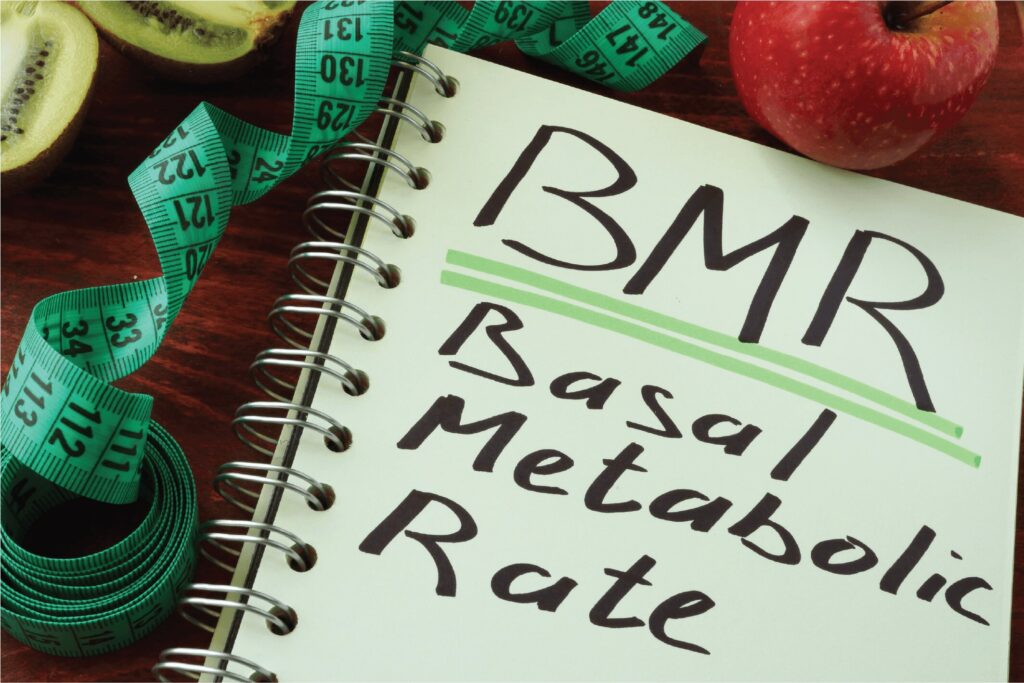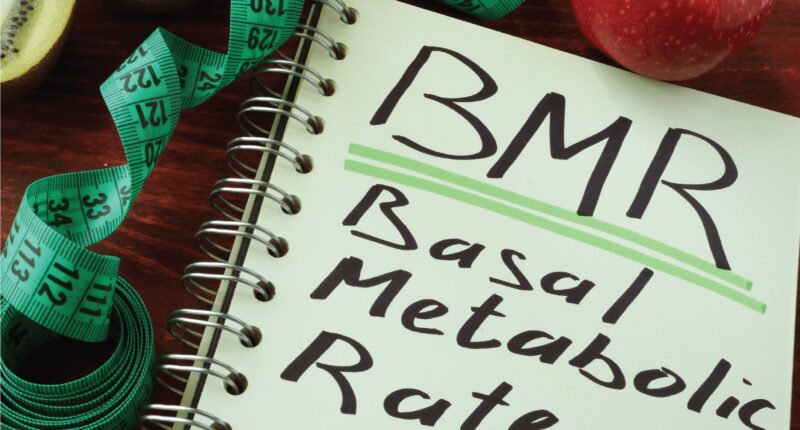Definition of BMR: Your basal metabolic rate (BMR) is the number of calories you burn as your body performs basic (basal) life-sustaining tasks. This is also commonly referred to as resting metabolic rate (RMR), which is the number of calories you would burn if you stayed in bed all day. In either case, many people use the basal metabolic rate formula to calculate their body’s metabolic rate.
Your BMR determines your basal metabolic rate, which accounts for about 60-70% of the calories we consume (“burn” or expend). It includes the energy your body uses to maintain your basic body functions of living and breathing, including:
- The beating of our heart
- The maintenance of body temperature
- Circulation
- Cell production
- Respiration
- Nutrient processing
Your unique metabolic rate, or BMR, is affected by a number of factors, including age, weight, height, gender, environmental temperature, diet, and exercise habits.
Fill in the weight, height, age and sex attributes below to calculate your basal metabolism rate.
Calculate Your Basal Metabolic Rate
All content presented are provided for informational and educational purposes only, and are not intended to approximate or replace professional medical advice, diagnosis, or treatment. Always seek the advice of your physician or other qualified healthcare provider with any questions you may have regarding a medical condition.
There are different ways to measure BMR. One of them is through thyroid function evaluation. It measures the rate of oxygen consumption under baseline conditions of overnight fast and rest from mental and physical activity. Because standard equipment for measuring and calculating BMR may not be readily available, BMR is easily estimated from oxygen consumed over a period of time by analyzing expired air samples. And can be measured. The test indirectly measures the level of metabolic energy expenditure or heat production.
Low values in the results indicate hypothyroidism. High values indicate the presence of thyrotoxicosis. Normal BMR percentages range from negative 15% to positive 5%. Most hyperthyroid patients have a BMR percentage of positive 20% or more and hypothyroid patients have a BMR of negative 20% or less. BMR is also altered by various medical conditions such as viral fever, pregnancy, medications, cancer, cholesterol, heart failure, polycythemia and Paget’s bone disease. These diseases tend to increase BMR. On the other hand, overweight or obesity, Cushing’s syndrome, anorexia, adrenal insufficiency and inactivity lower BMR.
The general formula for calculating BMR in female and male is:
Female: BMR = 655 + (4.35 x weight in pounds) + (4.7 x height in inches) – (4.7 x age in years)
Male: BMR = 66 + (6.23 x weight in pounds) + (12.7 x height in inches) – (6.8 x age in years)
BMR Variables:
Muscle mass: BMR is largely determined by body lean mass because lean mass requires more energy to perform energy-intensive activities. And that immediate energy is released through muscle activity. Anything that decreases lean mass will result in a decrease in BMR. As muscle mass increases, the body uses greater amounts of energy to maintain and control its basic daily functions, giving BMR a good boost in metabolic activity.

Age: Basal metabolic rate decreases linearly with increasing age. Basal metabolic rate depends on body size as it is reflected by weight, age, gender. Age is an important factor in human nutrition and diet. A newborn’s basal metabolic rate increases rapidly over the course of one year of life in proportion to their rate of muscle growth and development. A child reaches the peak of basal heat production at the age of two. It gradually decreases until the period of early adolescence (12-15 years of age). After puberty, BMR gradually decreases. Changes in BMR are different for children and adults because adults are more sensitive to changes in the environment, while children are always protected from environmental changes.
Genetics and Hormones: At the onset of puberty, basal heat production differs for males and females. Girls reach puberty two years earlier than boys, and when boys reach puberty, their basal energy expenditure is higher than that of girls and remains higher throughout life. This difference is due to the fact that men have more muscular and lean bodies (lower percentage of adipose tissue) than women. Genes have a major influence on weight because of the DNA and cell protein synthesis that controls the level of metabolism. Heredity is also responsible for genetic factors that affect BMR.
Pregnancy: BMR increases when a woman is pregnant. The total energy cost of pregnancy is largely determined by basal metabolic rate (BMR). Body weight gain combined with fetal weight gain or with increased levels of serum IGF-I concentration explained about 60% of the variation in the increase in BMR of pregnant women.
Climate: Climate and body temperature are important indicators of BMR because they determine an individual’s internal environment. People living in tropical climates typically have a BMR 5 to 20 percent higher than their counterparts living in more temperate regions. This is because it takes more energy to cool the body by giving off excess heat. Exercising in hot weather also puts an extra, extra metabolic load on the body.
Daily Calorie Requirement: Basal metabolism is usually the largest and largest component of a person’s total caloric needs. The daily calorie requirement is the BMR value multiplied by a factor between 1.2 and 1.9, depending on the type of activity. Calories depend largely on factors such as age, size, height, gender, lifestyle and overall health of the child.
Daily calorie needs largely depend upon the Activity factor. After calculating the BMR, multiply the result with an activity factor to know about the daily calorie needs.
| Activity Level | >Daily Calorie Requirement |
|---|---|
| Sedentary Lifestyle: little or no exercise | BMR * 1.2 |
| Slighty Active Lifestlye:Exercise 1-3 times/week | BMR * 1.375 |
| Moderately Active Lifestyle: Exercise 4-5 times/week | BMR * 1.55 |
| Active Lifestyle:Daily exercise or intense exercise 3-4 times/week | BMR * 1.725 |
| Very Active Lifestyle: Intense exercise 6-7 times/week | BMR * 1.9 |




